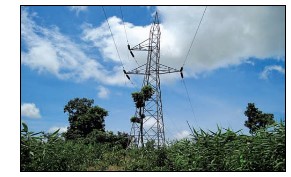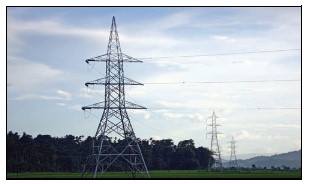 — Wallamphang Roy,
Managing Director, Power Carriers (India) Pvt Ltd
— Wallamphang Roy,
Managing Director, Power Carriers (India) Pvt Ltd
With a standing of nearly three decades,
Power Carriers (India) Pvt
Ltd is a predominant force in the power transmission contracting
sector in north-east India.
Wallamphang Roy shares his company's
operations and discusses the challenges of project execution in the
hostile terrains and climatic conditions of north-east India. Roy is
optimistic of his company growing significantly given that India will
need to build power transmission infrastructure from the
hydropower-rich northeast to the mainland. An interview by
Venugopal Pillai.
At the outset, please tell us in some detail about your company's
capabilities in the power transmission contracting sector.
Power Carriers has been in existence since 1982 and
our core strengths and capabilities have been in
building infrastructure in the transmission sector by
being involved in almost all major power transmission
project of the state. Our local knowledge of the geography
of this region has helped in effective surveying and
estimations thus leading to timely execution of projects. All
this has been achieved as we have competent, experienced
and knowledgeable manpower. To sum it up we provide end
to end solutions as far as the transmission contracting sector
is concerned.
We observe that Power Carriers has predominantly served
Meghalaya State Electricity Board. What are your plans of
catering to other north-eastern states and possibly
neighbouring eastern states like West Bengal?
Yes, Power Carriers (India) Pvt Ltd has predominantly executed
projects in the state of Meghalaya. However we have also had
several projects in other states such as Orissa, Andhra Pradesh,
Kerala and Assam. Of late we are aggressively pursuing plans to
spread our footprint to other states like Sikkim, West Bengal
besides other north-eastern states.
Execution of power transmission infrastructure projects,
especially overhead lines, can be a very challenging task. Tell us about common challenges faced and particularly the
challenges faced due to difficult topographic and climatic
conditions in north-east India.
The terrain in the North East is fraught with inherent
difficulties like hills, mountains, and cliffs in addition to this
road and other infrastructure is also a major impediment for
execution of projects. Since transmission lines predominantly
pass thorough forests and inaccessible areas, it makes it
more difficult to reach locations thus increasing labour for
head loading. The rainy season in the north-east lasts for
almost six months a year and no work is possible during this
period. All this hampers the progress of the work.
 Obtaining right-of-way and forest clearances for power
transmission projects have always been difficult subjects
in India. Over the nearly 30 years of your company's service
to the industry, do you see matters improving?
Obtaining right-of-way and forest clearances for power
transmission projects have always been difficult subjects
in India. Over the nearly 30 years of your company's service
to the industry, do you see matters improving?
Securing right of way in Meghalaya is indeed a major
challenge because of its unique land holding system where,
under the Sixth Schedule of the Constitution the private
individuals hold the right of land. This makes land acquisition
and clearances difficult and expensive. In the recent past
there have been efforts to make this more uniform and we
hope that the new land acquisition acts passed by the Centre
and states will help address these issues.
What is your general view on India moving to EHV and UHV
power transmission infrastructure like 765kV, 800kV and
even 1,200kV lines? How is Power Carriers (India) gearing
up to meeting EHV power transmission demand?
North-east India is estimated to generate more than
50,000 mw of power in near future of only a portion of this
can be utilized in the region. Most of the power will
therefore have to be evacuated outside the northeast to be
utilized in mainland India. This will require a very strong
infrastructure for transmission of power, and the Chicken's
Neck area near Siliguri will curtail the capability of
evacuation of power in 220kV/440kV lines. It is thus
imperative that in the near future EHV of 765kV or 800kV
may be set up for the same. As of now the NEC, the nodal
funding agency, or PGCIL have not spelt out any plans.
Tell us about some interesting and challenging projects
successfully executed by Power Carriers.
PCIPL has had the opportunity to set up some of the most
challenging projects in Meghalaya. All projects carried out
by the company are challenging since the terrain is difficult
in the areas where work is carried out. But the most
challenging has in the coal belt with a lot of coal reserves
where mining activities are prevalent. It is indeed a
challenging feat since the mining activities endanger the
life and the stability of the tower.
Given that there is huge potential for hydropower
generation capacity in north-east India and the subsequent
need for evacuating power to other energy-deficient parts
of India, how do you see business opportunities for Power
Carriers in north-east India?
The recent spurt in investment and recognition of the
hydropower generation capacity in the north-east certainly
augurs well for PCIPL. We have always been a major player in a
small state like Meghalaya but the new rules of the business and
turnkey solutions expected from power transmission
companies make it imperative for us to upgrade of human skills,
technology adaptation and the financials. As part of the process
we have introduced a project to empower and retrain our
manpower. We have recruited new people in
the past two years and also look to get
ourselves ISO certified by the year end for
which the process is in place.

Turnkey solutions make it imperative for us
to tie up with manufacturing companies for the
supply of towers which will help us become
competitive. In the past three years we have
been associating with various tower
manufacturing companies from Kolkata and
other places in India and have successfully bid
for major projects. We intend to tie up with
potential investors who would want to set up a
plant in Guwahati or Siliguri or go into an
understanding with tower manufacturers for
long term relationship to remain competitive.
With your wide experience in power
transmission contracting, do you plan to enter
related areas like telecom towers for
instance?
Yes, in addition to the transmission line
construction work that we have been doing for
the past so many years, we also intend to enter
the annual maintenance of transmission lines
business, which we feel is a very lucrative
area, having the experience of working in these difficult terrains
our expertise will help the AMC segment.
Yes, the telecom towers business is a great opportunity but
that will require a tie up with a tower manufacturer. It is
something that we are seriously considering.
Please summarize your growth plans for Power Carriers in the
medium term.
As I said earlier, Power Carriers intends to be a
major player in the infrastructure for
transmission industry in the north-east. We are
looking at expanding our area of operations by
moving into newer geographies in the region.
Annual maintenance of transmission lines is
another area that we will focus on in coming
years. Our objective in the medium term is to be
an end-to-end provider as far as this business
is concerned by providing the best value for
investment through good governance, timely
execution of projects, competitive pricing and
transparency in our dealings.
We are committed to exceeding the
expectations of our customers through
continued improvement of quality standards,
keeping abreast with the latest technology by
innovative training and development methods
of our work force, ensuring high safety
standards within the organisation and those of
our sub-contractors.
We have now ventured into the operation and
maintenance of the EHV transmission sector. The
setting up of telecom towers and electrification
of railway lines are other sectors that we would
be interested in the near future.